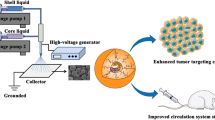Abstract
Over the past few decades, there has been considerable interest in developing protein nanoparticles as drug delivery devices. The underlying rationale is their exceptional characteristics, namely biodegradability and nonantigenicity. Herein, phase separation method was used to prepare 5-fluorouracil-loaded bovine serum albumin (BSA) nanoparticles. Drug release was tracked by continuous flow dialysis technique. Effect of process variables on loading efficiency of 5-fluorouracil was investigated and optimized through Taguchi’s M16 design with the amount of entrapped drug as response. Optimum condition was found to be 2 mg/mL of 5-fluorouracil, 3.7 mL of added ethanol, 176 µL of glutaraldehyde, drug–protein incubation time of 30 min, and pH of 8.4 for 200 mg of BSA in 2 mL drug solution. pH had the most noticeable effect on the amount of entrapped drug, but glutaraldehyde had the least. Mean diameter and zeta potential of fabricated nanoparticles under these conditions were 210 nm and −31.7 mV, respectively. Drug-loaded BSA nanoparticles suspension maintained constant release of drug for 20 h under experimental conditions, so this colloidal drug carrier is capable of releasing drug in a sustained manner.



Similar content being viewed by others
References
F. DeJaeghere, E. Doelker, and R. Gurny. Nanoparticles. In E. Mathiowitz (ed.), Encyclopedia of Controlled Drug Delivery, Wiley, Hoboken, 1999, pp. 641–664.
S. M. Moghimi, A. C. Hunter, and J. C. Murray. Long-circulating and target-specific nanoparticles: theory to practice. Pharmacol. Rev. 53:283–318 (2001).
B. G. Muller, H. Leuenberger, and T. Kissel. Albumin nanospheres as carriers for passive drug targeting: an optimized manufacturing technique. Pharm. Res. 13:32–37 (1996).
G. V. Patil. Biopolymer albumin for diagnosis and in drug delivery. Drug Dev. Res. 58:219–247 (2003).
M. Michaelis, K. Langer, S. Arnold, H. Doerr, J. Kreuter, and J. Cinatl. Pharmacological activity of DTPA linked to protein-based drug carrier systems. Biochem. Bioph. Res. Co. 323:1236–1240 (2004).
C. Weber, C. Coester, J. Kreuter, and K. Langer. Desolvation process and surface characterization of protein nanoparticles. Int. J. Pharm. 194:91–102 (2000).
M. Merodio, A. Arnedo, M. J. Renedo, and J. M. Irache. Ganciclovir-loaded albumin nanoparticles: characterization and in vitro release properties. Eur. J. Pharm. Sci. 12:251–259 (2001).
M. Merodio, J. M. Irache, F. Valamanesh, and M. Mirshahi. Ocular disposition and tolerance of ganciclovir-loaded albumin nanoparticles after intravitreal injection in rats. Biomaterials. 23:1587–1594 (2002).
W. Lin, M. C. Garnett, S. S. Davis, E. Schacht, P. Ferruti, and L. Illum. Preparation and characterization of rose Bengal-loaded surface-modified albumin nanoparticles. J. Control. Rel. 71:117–126 (2001).
S. S. D’Souza, and P. P. DeLuca. Methods to assess in vitro drug release from injectable polymeric particulate systems. Pharm. Res. 23:460–474 (2006).
S. S. D’Souza, and P. P. DeLuca. Development of a dialysis in vitro release method for biodegradable microspheres. AAPS PharmSciTech. 62:E323–E328 (2005).
J. W. Kostanski, and P. P. DeLuca. A novel in vitro release technique for peptide-containing biodegradable microspheres. AAPS PharmSciTech. 11:4 (2000).
M. Boisdron-Celle, P. Menei, and J. P. Benoit. Preparation and characterization of 5-fluorouracil-loaded microparticles as biodegradable anticancer drug carriers. J. Pharm. Pharmacol. 47:108–114 (1995).
N. Faisant, J. Siepmann, and J. P. Benoit. PLGA-based microparticles: elucidation of mechanisms and a new, simple mathematical model quantifying drug release. Eur. J. Pharm. Sci. 15:355–366 (2002).
A. Bozkir, and O. M. Saka. Formulation and investigation of 5-FU nanoparticles with factorial design-based studies. Il Farmaco. 60:840–846 (2005).
Y. Zheng, W. Yang, C. Wang, J. Hu, S. Fu, L. Dong, L. Wu, and X. Shen. Nanoparticles based on the complex of chitosan and polyaspartic acid sodium salt: preparation, characterization and the use for 5-fluorouracil delivery. Eur. J. Pharm. Biopharm. 67:621–631 (2007).
L. Liu, P. Jin, M. Cheng, G. Zhang, and F. Zhang. 5-fluorouracil-loaded self-assembled pH-sensitive nanoparticles as novel drug carrier for treatment of malignant tumors. Chin. J. Chem. Eng. 14:377–382 (2006).
S. Li, A. Wang, W. Jiang, and Z. Guan. Pharmacokinetic characteristics and anticancer effects of 5-fluorouracil loaded nanoparticles. BMC Cancer. 8:103 (2008).
P. A. McCarron, A. D. Woolfson, and S. M. Keating. Sustained release of 5-fluorouracil from polymeric nanoparticles. J. Pharm. Pharmacol. 52:1451–1459 (2000).
A. Lamprecht, H. Yamamoto, H. Takeuchi, and Y. Kawashima. Microsphere design for the colonic delivery of 5-fluorouracil. J. Control. Rel. 90:313–322 (2003).
K. Santhi, S. A. Dhanaraj, V. Joseph, S. Ponnusankar, and B. Suresh. A study on the preparation and anti-tumor efficacy of bovine serum albumin nanospheres containing 5-fluorouracil. Drug Dev. Ind. Pharm. 28:1171–1179 (2002).
C. Lo, K. Lin, and G. Hsiue. Preparation and characterization of intelligent core-shell nanoparticles based on poly(d,l-lactide)-g-poly(N-isopropyl acrylamide-co-methacrylic acid). J. Control. Rel. 104:477–488 (2005).
K. Langer, S. Balthasar, V. Vogel, N. Dinauer, H. von Briesen, and D. Schubert. Optimization of the preparation process for human serum albumin (HSA) nanoparticles. Int. J. Pharm. 257:169–180 (2003).
R. K. Roy. A Primer on the Taguchi Method, Van Nostrand Reinhold, New York, 1990.
Acknowledgments
We appreciate partial support of this research by the Iranian National Science Foundation.
Author information
Authors and Affiliations
Corresponding author
Rights and permissions
About this article
Cite this article
Maghsoudi, A., Shojaosadati, S.A. & Vasheghani Farahani, E. 5-Fluorouracil-Loaded BSA Nanoparticles: Formulation Optimization and In Vitro Release Study. AAPS PharmSciTech 9, 1092–1096 (2008). https://doi.org/10.1208/s12249-008-9146-5
Received:
Accepted:
Published:
Issue Date:
DOI: https://doi.org/10.1208/s12249-008-9146-5




